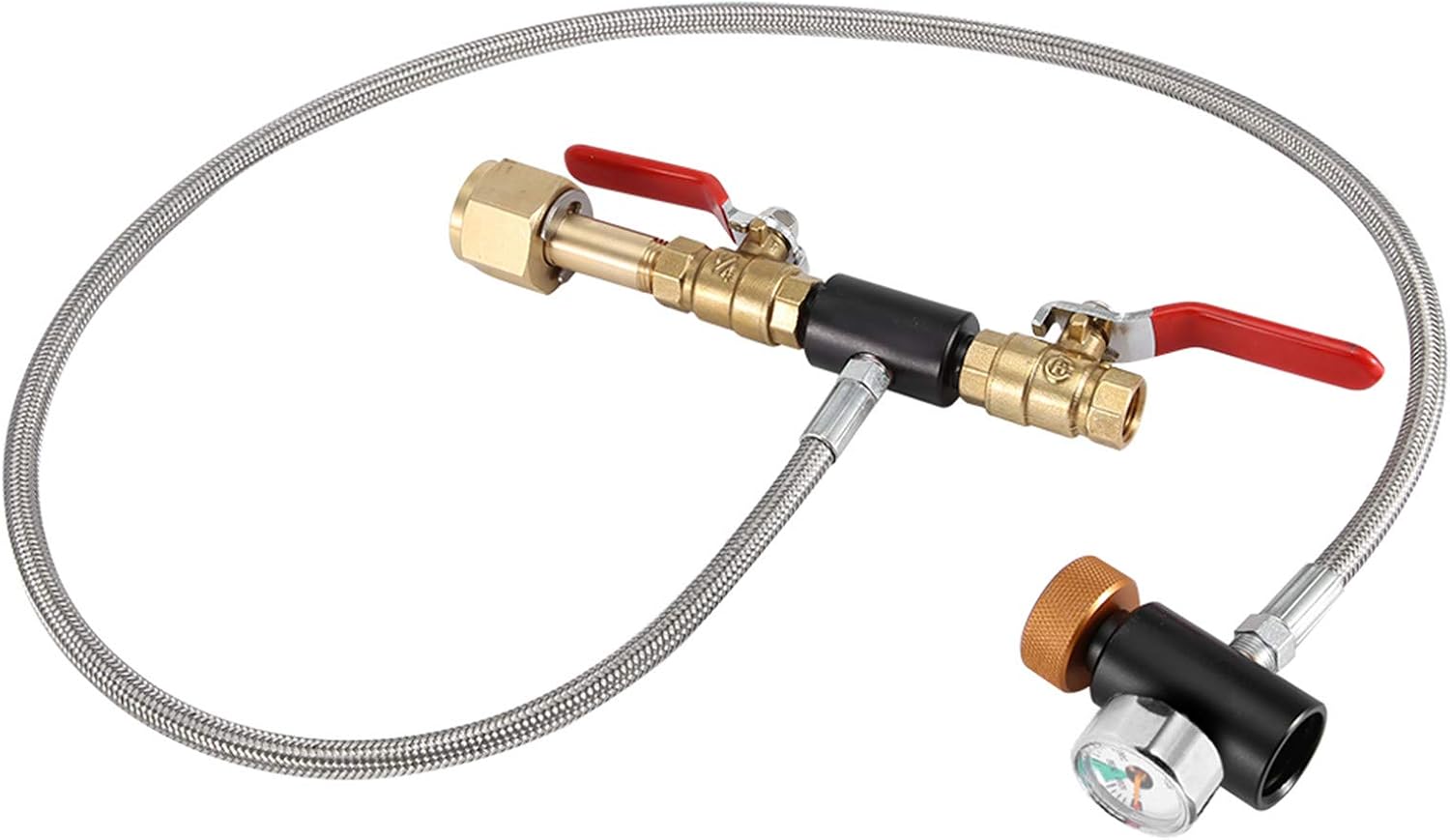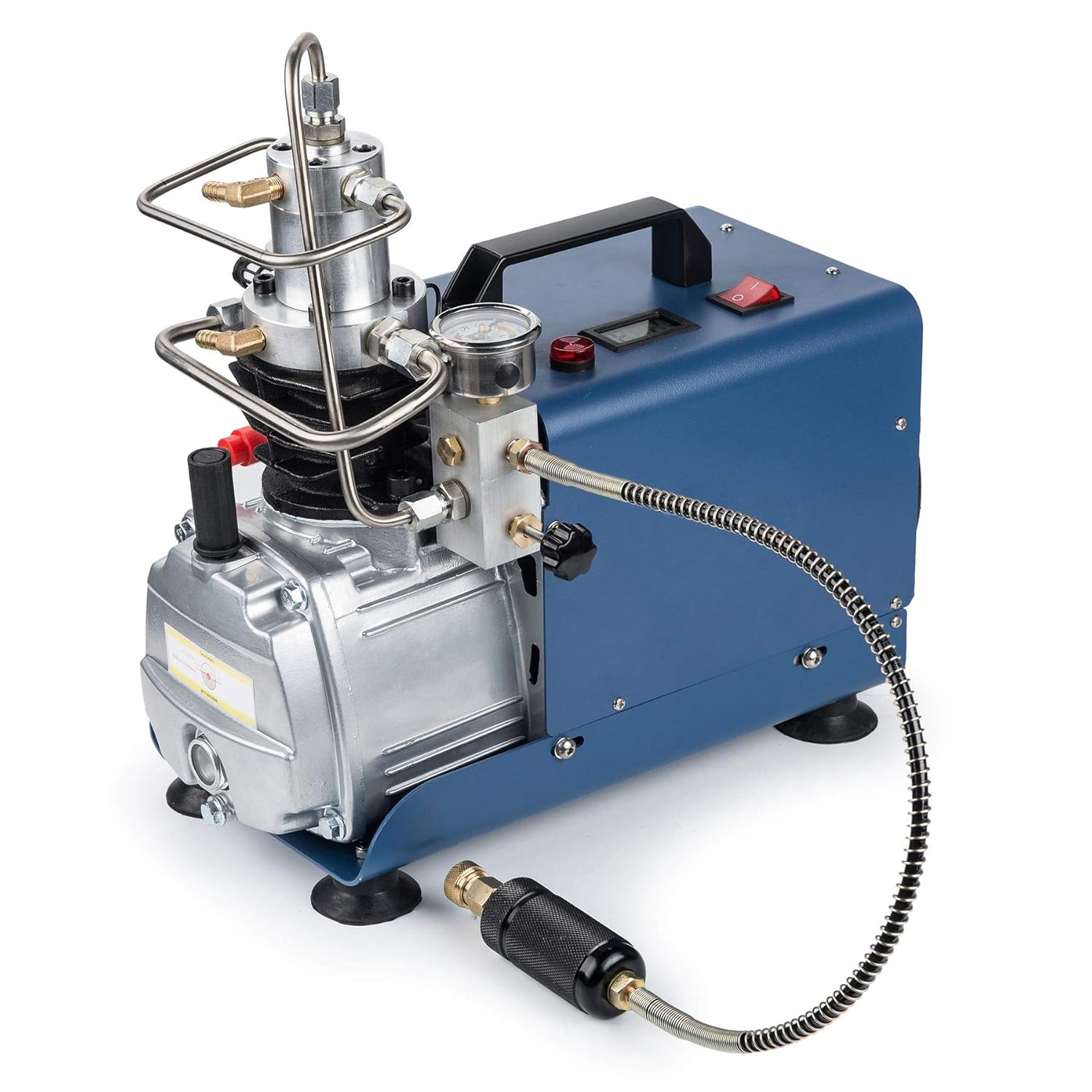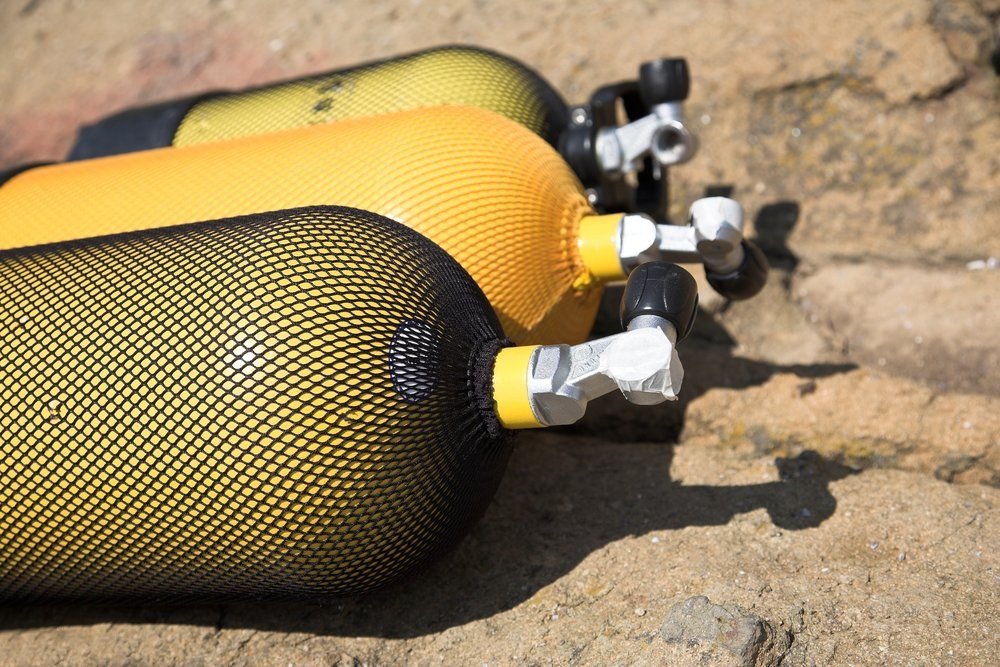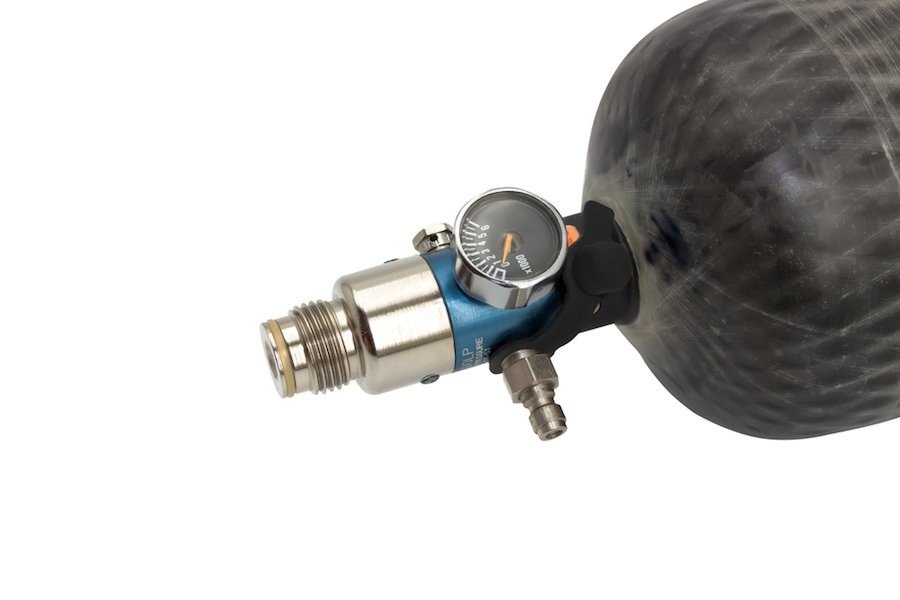.
If you have a CO2 tank for any application, you may be wondering how to refill it. Can you put compressed air into a CO2 tank?

If so, how?
Is it even safe?
To refill a CO2 tank with an air compressor, you need a simple adapter that will connect between the compressor and your CO2 tank.
ProTip: Welding Gas Supply Stores are the easiest & cheapest place to refill your Co2 Tanks (see US Map)
Sodastream has a cartridge exchange system. for their CO2 cartridges.
Steps To Filling A Co2 Tank
Items you will need:
Note: Co2 Tanks may have a lower PSI rating than compressed air tanks (click to read more).

- Co2 Tank Adapter
- Air Compressor Capable of Producing 3,000 PSI
- Safety training (this blog post doesn’t count)
Find the general steps to filling a CO2 tank with compressed air below:
#1 Check Integrity
All tanks should have the date of their last hydro-testing printed on the side. In the US, most tanks are required to get new hydro-testing every 5 years. Some smaller unit don’t need to get hydro-tested after their initial test. The date of the last hydro-test will be printed on the cylinder in a format that resembles this: “09C14”
In this example, the first two numbers give the month while the second numbers provide the year of the last hydro-testing. In between the numbers, the letter or letters tell you which independent certifying agency approved the cylinder inspection.
All tanks should have the date of their last hydro-testing printed on the side. In the US, most tanks are required to get new hydro-testing every 5 years. Some smaller unit don’t need to get hydro-tested after their initial test. The date of the last hydro-test will be printed on the cylinder in a format that resembles this: “09C14”
In this example, the first two numbers give the month while the second numbers provide the year of the last hydro-testing. In between the numbers, the letter or letters tell you which independent certifying agency approved the cylinder inspection.
If the tank has been testing and approved in the last 5 years, it should be okay to use. If it hasn’t, you should first get it hydro-tested to make sure it’s safe to use.
#2 Understand the Tank PSI Rating
All tanks have their PSI rating imprinted on the outside of the canister. It may be on the side of the bottom. It should be written something like this: “3AL1800” or “E3000” followed by a long serial number that begins with a letter.
The first sequence of letters or numbers shows which regulatory authority’s specifications the cylinder adheres to. The short sequence of numbers after that is the PSI rating. In the examples above, the first tank has a PSI rating of 1800 while the second one is 3000.
All tanks have their PSI rating imprinted on the outside of the canister. It may be on the side of the bottom. It should be written something like this: “3AL1800” or “E3000” followed by a long serial number that begins with a letter.
The first sequence of letters or numbers shows which regulatory authority’s specifications the cylinder adheres to. The short sequence of numbers after that is the PSI rating. In the examples above, the first tank has a PSI rating of 1800 while the second one is 3000.
Never try to fill a tank beyond its rated capacity. If you’re filling a CO2 tank with compressed air, it’s better to underfill than to overfill. If the air you’re using is 100% dry and oil-free, you can fill up to the rated capacity. If you can’t guarantee that it’s 100% dry and oil-free, it’s better to underfill to be on the safe side.
Some folks calibrate at 2 seconds per ounce. A 12 ounce container would need 24 seconds to fill with that calculation.
#3 Use The Right Fill Adapter

CO2 tanks and compressed air tanks come with different fittings to help you avoid accidentally putting the wrong type of gas in the cylinder. You’ll need an adaptor to get by this. Adaptors allow you to connect to the CO2 tank as if it were a compressed air tank.
Compressed air tanks vary in their threading depending on their primary use. Most CO2 tanks have CGA-320 threading or CGA 347 threading. Before you buy any adaptors, make sure you know what threading your compressor uses and what threading your CO2 bottle has so you can get the right fit. You need a complete seal, or you won’t be able to do it.
#4 Empty the Tank Completely
Before you add anything into the tank, take the time to empty the CO2 tank. When you attach your adaptor to the tank, hook it up to the hose fitting for the air compressor without connecting the compressor itself. There should be a valve to open the tank and let any remaining air escape. Before you fill it up, close this valve again once you’ve bled the air.
#5 Either use a CO2 Tank Or a High-Pressure Air Compressor
To refill with CO2, you will need a CO2 tank. These can be purchased from any welding supply store. You use the large tank to fill your smaller canisters.
To fill a CO2 cartridge with air, you’ll need a high-pressure air compressor. You cannot fill one fully with a hand pump or any pump meant for tires since those only go to 150 PSI.
The compressor must be able to dispense the correct PSI to match the rating of the tank.

You will need a specialized high-pressure compressor such as the Orion Motor Tech High-pressure Air Compressor Pump. This compressor works for tanks up to 4500 PSI, which is all you need for most home use. It comes with the standardized fill nipple, so you can plug this in and start using it right away.
While this particular compressor won’t give you a private scuba fill station, it’s great for any other compressed air uses. There is a built-in PSI pressure gauge and a bleed-off valve. The compressor will auto-stop if it gets too hot or if the vessel it is filling reaches the max of 4500 PSI. It’s not adjustable to auto-stop at a specific PSI level for other sizes, so you’ll have to watch it closely.

If you want to fill your own tanks for Scuba, look at the D Machinery 300Bar compressor unit which is designed to create compressed air to standards that meet human respiratory requirements. There are also adapters designed to convert paintball compressors to a scuba tank.
A standard air compressor cannot reach these high PSI levels and does not allow you to fill your tanks at home.

Tanks: CO2 Vs. Compressed Air (HPA) Vs. Nitrogen
Three types of pressured gas cylinders are commonly employed. They all serve different purposes and work in different ways, though you can see similarities in each one.
CO2 tanks come filled with either gaseous or liquid CO2 (carbon dioxide). When you use them, the CO2 reverts to its gaseous state (if it wasn’t already gaseous).
Compressed air tanks, sometimes called High-Pressure Air (HPA) tanks, are filled with normal oxygen. Some are filled with highly filtered, breathing quality air while others use non-filtered air. Most filtered air is exclusively for use with SCUBA tanks and other breathing apparatuses. You can use compressed air for many of the same purposes as CO2.
Nitrogen tanks are filled with compressed nitrogen gas. They are not the same as NO2 tanks, which use nitrous oxide. These tanks are not as common as either CO2 or compressed air so that we won’t be going into much detail about them.
A paintball marker’s tanks are generally rated to 4,500 PSI. A regulator lowers the output pressure to 450 PSI for gameplay.
Is It Safe to Put Compressed Air in a CO2 Tank?
You can put compressed air into a CO2 tank. However, you need to be very attentive to make sure you’re doing everything right. If you make a mistake, the CO2 tank may explode under pressure and injure you or others around the area. While it’s possible to do it safely, it will require you to take some steps beforehand to make sure you’re doing it right since you are working with a higher pressure.
Find the steps to filling a CO2 tank with compressed air below.
What Is Hydro-Testing?
This test is where water is inserted to remove all air and then pressurized to 1.5 times the rated pressure is used to make sure a pressurized container (or piping, boilers, or other closed systems) can safely accommodate the meet the stamped ratings. Hydro-testing will uncover leaks, ruptures, or other damage to a tank.
In the US, hydro-testing is required by law if you want to continue filling up a pressurized tank. It’s performed at different intervals, usually every 5 years. There are various methods of hydro-testing, but each yields the same results. Many fill stations can also perform hydro-testing.
Types of Compressed Air Tanks
Before you add air, you need to know what tank you are working with.
Regular compressed air tanks are different than CO2 tanks. CO2 is a denser gas than compressed air, which means it can be stored at a lower pressure. To store compressed air, you need a stronger tank that can withstand higher PSI.
Whereas the average CO2 is built for between 800 – 1800 PSI (dependent on the size and temperature of the gas inside), compressed air tanks are built for 3000 or 4500 PSI depending on their intended use. They come in two types: fiber-wrapped tanks and aluminum tanks.
Fiber-Wrapped
These tanks are made with carbon fiber or fiberglass wrapped into the shape of a cylinder. They’re lightweight and able to contain higher PSI than aluminum tanks. A standard fiber-wrapped tank can be around 4500 PSI. No matter which type of fiber is used, these tanks will always weigh less than an aluminum tank with similar PSI ratings.
Because of their lighter weight, fiber-wrapped tanks are better for handheld use. However, they’re far more expensive than aluminum tanks and do not last as long. Fiber-wrapped tanks are also not as durable against impact damage, which could be a problem in some situations. For home use, fiber-wrapped cylinders don’t give any real benefit over aluminum.
Aluminum
As a heavier material, aluminum tanks are usually built to be smaller. Because of this, they have a lower PSI rating, generally closer to 3000 PSI. Aluminum tanks are much cheaper than fiber-wrapped tanks and will last longer. They’re also more durable, lasting for more than 15 years if kept well.
Occasional hydro-testing is required if the tank is larger than a specific size (some small aluminum tanks do not need hydro-testing). While aluminum tanks can theoretically be built in any size, you’re likely to find more small tanks than large tanks because of the increased weight. For handheld use, such as with a paintball gun, larger tanks are too bulky and heavy to be practical.
Aquariums
In most home aquariums a little “bubbler” is all that is needed to keep the tank healthy. In aquariums that grow underwater plants, a CO2 system can provide more vibrant growth while combating unwanted algae.
Aquarium plants use CO2 that’s dissolved in the tank water to photosynthesize and grow faster. If you want to keep a tank with a large number of plants, CO2 cartridges help you maintain an excellent environment for growth.
CO2 Tank Refill Options
To have a CO2 tank refilled with CO2, you can go to several different places. Paintball shops, welding supply stores, and any business that refills fire extinguishers, home brewery shops, sports stores, some aquarium-focused pet shops, dive shops, and more.
If you want simplicity, some stores offer tank exchanges. It’s quick and easy to go in with your empty tank and come out with a full one. You can also buy a large CO2 tank and use it to refill your smaller tanks if you have the right fittings.
HPA Scuba Tanks
For HPA, you will have fewer options and may need to look into a more specialized shop instead. Some shops may not allow you to fill a CO2 tank with compressed air.

Comparing CO2 Vs Compressed Air for Common Uses
Both CO2 and compressed air have a lot of uses in modern life. From sports to hobbies, you can put both of these gaseous compounds to good use. In a few cases, CO2 and compressed air are relatively interchangeable.
Here are a few common uses for both and how they differ in each context:
Paintball
You can either CO2 or compressed air when playing paintball. However, there are some differences in what you do.
CO2 is the most common choice because the paintball tanks are lightweight and easy to fit onto most markers. Refills have to be done by those with the right equipment at a fill station and require that tank is empty first.
With CO2, you have to use paintball guns that are made to withstand the pressure and temperature of the CO2. Some markers may not handle CO2 well, especially when you’re firing rapidly. If you fire quickly using CO2, or if you’re playing in a cold environment, the pressure exerted by the CO2 can vary dramatically and may create issues with firing consistently when on the paintball field. Tank covers can sometimes help with temperature swings, but only marginally. Higher PSI shots will not be as accurate and may break balls inside the barrel.
Compressed air canisters are larger and weigh more than CO2 cylinders. You can top these cylinders off without having to empty them, but it’s not as common to find a business that can fill this kind of tank. Air tanks for paintball have very high PSI ratings and cannot be supplied by hand pumps or regular air compressors.
The higher PSI the tanks, the more shots you can take between refills. Air cylinders usually outlast similarly-sized CO2 tanks.
Unlike CO2, compressed air is not affected by weather and temperature changes, so you’ll fire consistently. You can use it with any type of marker, with many paintball guns being created especially for its use.
However, you will need to adjust the pressure from a compressed air tank to match your gun type as the default will be much too high.
In the world of paintball, CO2 tanks are the cheaper alternative with which to enter the sport. They are also what most pro shops are designed to work with.
The tanks are a lot cheaper, and it’s easy to find a place to fill them for a reasonable price. Compressed air setups are much more expensive, and it’s more challenging to find a place that will fill them. But, as TacticsFaq points out, filling them should be relatively inexpensive, and they may end up costing less in the long run.
Beer Making
Draft beer kegs use CO2 for dispensing into glasses. You can carbonate the beer itself or hook up the CO2 line to the output on the keg to pressurize the dispenser while carbonating it as it dispenses. While you could theoretically use compressed air in place of CO2, you may not want to for a couple of compelling reasons.
First, air will cause the beer to oxidize faster than it should. It will go stale very quickly when exposed to oxygen rather than CO2. CO2 is a byproduct of the beer fermenting, so using CO2 for pressurization won’t affect the taste of the beer at all and will keep it fresh for longer.
Secondly, it can easily contain other things you wouldn’t want to expose your beer to. If there’s anything in the air you compress, it will mix in with the beer and may affect the taste and quality. It may not be safe, depending on what’s in the air you compress.
Finally, natural air will not give the beer a tall frothy head while CO2 will. Air does not absorb into the beer and create the same carbonated reaction as CO2.
Aquariums
In most home aquariums a little “bubbler” is all that is needed to keep the tank healthy. In aquariums that grow underwater plants, a CO2 system can provide more vibrant growth while combating unwanted algae.
Aquarium plants use CO2 that’s dissolved in the tank water to photosynthesize and grow faster. If you want to keep a tank with a large number of plants, CO2 cartridges help you maintain an excellent environment for growth.
Homemade Soft Drinks
CO2 is one of the components used with homemade soda machines, including the Soda Stream. For similar reasons as with beer dispensing, CO2 is a better choice than compressed air. It’s challenging to maintain high enough air quality with home air compressors to ensure a safe result. You will want to buy a replacement canister or get yours refilled with pure CO2 at a local authorized retailer
Should You Fill Your Co2 Tank With A Compressor?
Most shops just purchase bulk tanks and refill their Co2 off of that.
It’s the safest option, and the one I’d recommend!
 Skip to content
Skip to content

